This month Lone Hansen caught up with Sue Skelly, a woven cedar and button jewelry artist from Poulsbo. Hansen met Skelly a couple of years ago at Front Street Gallery while Hansen was representing Peninsula Music & Art.
Here are excerpts from Lone Hansen’s extensive conversation with artist, Sue Skelly. Some wording and order has been revised to provide further clarity.
Lone Hansen: As an artist, how’s life treating you with the pandemic?
Sue Skelly: It’s a little bit different but it’s not very different. I’m used to living and working alone. And creating alone. I’m in my lane here. I do visit Front Street Gallery two afternoons a month. It’s good to get out. Overall, I’m doing fine with the dogs.
Hansen: What’s making it easier?
Skelly: The thing I have felt grateful for is that at this stage of my life I’m not striving to build a business or become recognized. I’m OK the way I am. I feel for those who are, maybe 40, and still trying to establish themselves in this type of work because it’s lean. It’s always lean but it’s even leaner now and I think it’s pretty serious for some people.
Hansen: How are you doing at the Front Street Gallery. Are you selling anything?
Skelly: Yes, I am. I have a half membership there, so my space is small. I can’t present my cedar because of my space allocation.
Hansen: When did you start working with cedar?
Skelly: I’ve been doing cedar for 30 years or more. It’s what I love doing. I started out doing fencing when I had a landscaping business in Seattle. I did a lot of gardens and then I got into garden construction. I started building a lot of arbors, fences, gates, and all that kind of stuff. I then took a trip to England – Cornwall area. I saw for the first time in my life wattle fences that are made out of slash out of the hedge ropes. Some of these go for miles and miles. And there’s livestock behind them like sheep. They’re functional and it’s just brush.

Hansen: How did you apply that inspiration?
Skelly: I had just bought five acres of raw land. We were clearing to build a road and I was using all this cedar from the lumber yard by cutting most of it away to make these cute little arches. As I was clipping big cedar branches [I noticed] that they all had that same exact shape, inverted, as an arch. So there it was. And it was cedar, and it was in the round, and it was whole. And I had lots of it. I started collecting all those branches and sticking them behind the trees. I tied them in bundles and thought, “I’m going to make an arbor out of these!” Lo and behold, I asked a client in Seattle, “Can I build you a woven cedar twig fence?” She goes, “OK!” I went for it. I kept working on it. I’m real fastidious – like a dog with a bone when I get an idea. And I made it happen. Then I just kept going. I kept doing more forms and more shapes. I just marvel at the material and what that tree has to offer.
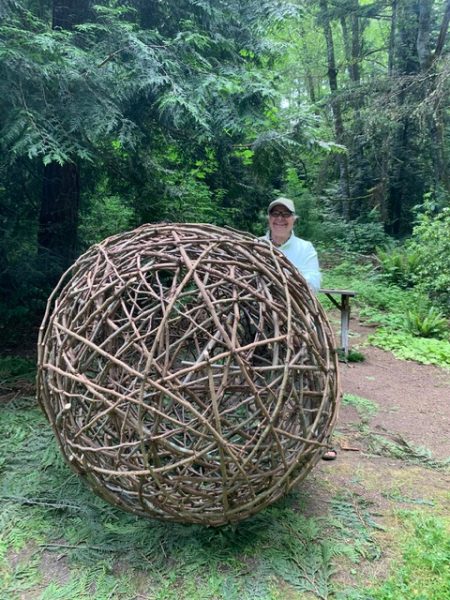
Hansen: When did you build your first cedar fence? And are ideas still coming?
Skelly: 1987. I hung with it and my ideas are still coming. I don’t get bored. I get excited. I’ve got 12.5 acres of woods now and there are a lot of cedar trees. I go out with loppers and I harvest what I need. Turns out this is why it’s called ‘sustainability.’ I know how to sustain my resources out here.
Hansen: Did that lead to other opportunities?
Skelly: I got hooked up with the Northwest Basketry Guild. I met a lot of people of the same ilk. I met some that were using cedar bark that the Native Peoples here have used forever. I started taking classes from teachers in the Basketry Guild. It was a quick translation for me to appreciate that aspect of it. I was really into the wood and branches but now I could use the bark. Then I learned to use the roots.
Hansen: Do you still build fences?
Skelly: I don’t build fences anymore. When the 2008 recession hit I used to work on commission. That business clamped down and I had nothing. I had lost my nursery business, my house and everything after going through a divorce. I moved into my studio and turned it into half house/half studio. And I had always worn necklaces and every dog that I owned had a button collar that I sewed.

Hansen: Is that how you got into the button business?
Skelly: I started collecting buttons when I was 20, while I was in college. I attended Minnesota State College in Southern Minnesota where I got a Fine Art degree with three art majors – ceramics, glass blowing, and print making. One day I went to a Goodwill and was looking at all these buttons. And I realized – these little buttons are not plastic, these buttons are made out of seashells and I was just enamored by that. They were plentiful, affordable, and easily available. I started collecting them and stashing them.
Then I picked up a couple of button books and read them. I started learning about other materials and I joined the National Button Society in 1985. I attended a national button show in Tacoma and was just enamored by the whole thing. There were so many buttons! To me, they were an art object already.
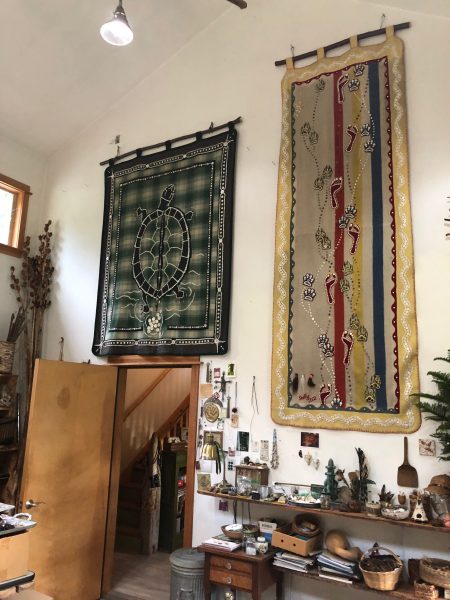
Hansen: You define buttons as art object… How did you arrive at that?
Skelly: When I first moved to Seattle (I grew up in Minnesota) I ended up moving into this funky walk up apartment in the U-District. I was only two blocks from the Burke Museum and it was free at the time. They had a button blanket show. Most of the people making the blankets were Haida (Salish people). The blankets were big and were made out of traded blankets from the Europeans with European mother of pearl buttons. The Haida turned the buttons into their regalia. They had family crests and dance robes. I later read more about it. I learned that the Haida took these buttons from the Brits – who wore regalia with mother of pearl buttons. I thought, what a cool transition – from the Brits to the Haida to the Burke. And now it’s going to be me! Because I have those buttons and big wool blankets.
Hansen: How did you start collecting them?
Skelly: I just kept collecting them at every garage sale. I always got compliments, so after the ’08 crash I thought, “This is something I can do.”
I had a 32-gallon can full in my shed. So, I put tarp on the lawn and started sorting. They were made out of horn, different kind of shell, different species of shell, china, porcelain, print, wood, celluloid – all natural materials. And some plastic. I started learning how the buttons were made through membership in three button groups — the National Button Society (5,000 members strong); the Washington State Button Society; and a little peninsula button club in Sequim.
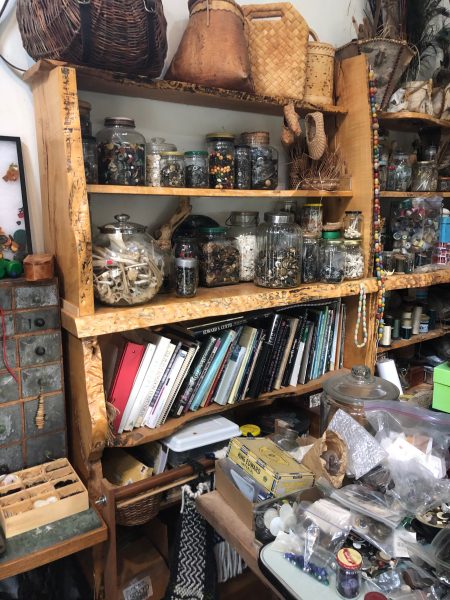
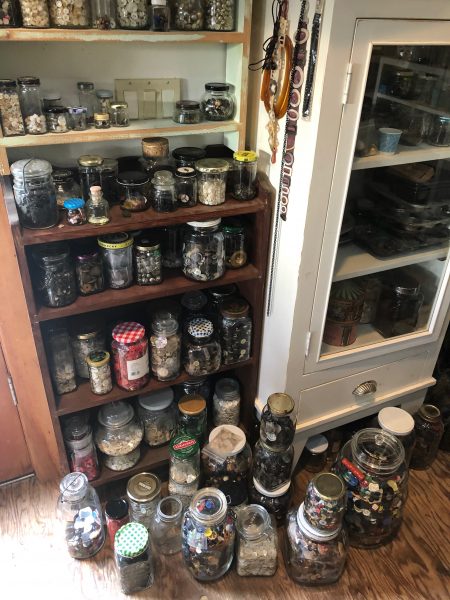
Hansen: What did you learn about buttons?
Skelly: How to design. You need to balance them and not corrode buttons – there’s chemistry with buttons. I started designing these necklaces. I never thought I could part with them because they seemed precious to me. When I started I didn’t use my really good stuff. When I started selling them, people were really tuned into them and it took off. I got better and better at it. I then realized, “There are people who love these buttons just as much as I do, and I’ll start using my better stuff and making nicer pieces.” Now I buy a lot of buttons. Not every button is going to make jewelry – you need to use quality stuff. It takes more work to use plastic ones than it does to make a shell one because shells are uniformly thick.
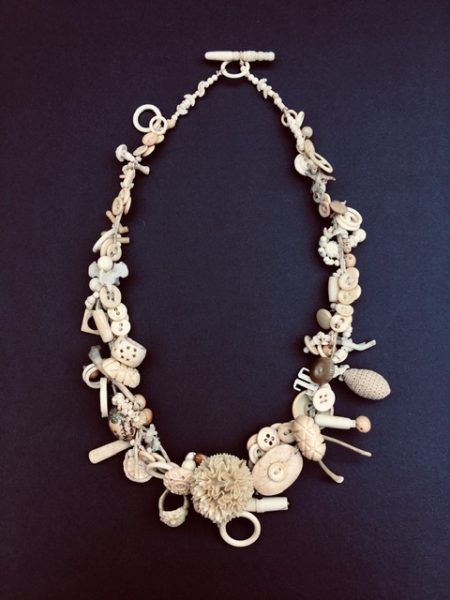
Hansen: How do you make the clasp?
Skelly: I make the clasp out of a ring made out of bone that people used to embroider over and make fancy buttons. Before, the armature was this bone ring. Nowadays they make them out of plastic, but they used to be made out of bone – all different sizes. I make these button necklaces and I use the bone ring on the end and for the clasp.
Hansen: When you look down the road, what do you see?
Skelly: I feel very fortunate. I have two mediums now – I have cedar and I have buttons. I can go whole hog on one for a couple of months. Then I realize I’m missing the other and then I switch gears. I switch back and forth. I’ve also been making elaborate wall hangings. I have a lot of ideas of where I can go with that.
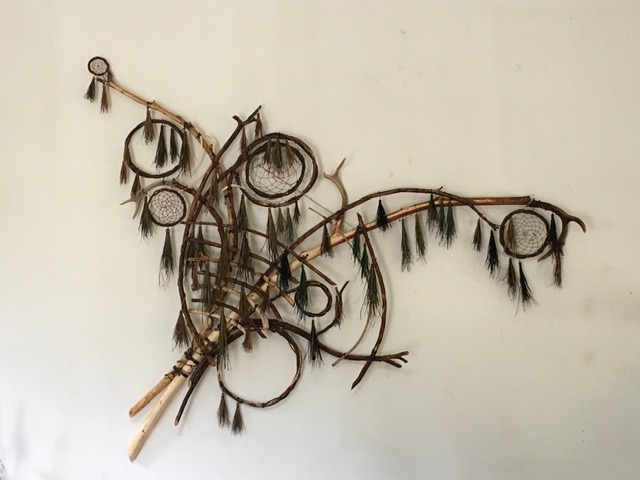
Hansen: What’s your connection to cedars?
Skelly: I find the cedar work is more serious artwork because it’s me and the tree. The cedar tree and I work really well together and I consider it to be a kind of partner. I love that whole process. I love being in the woods, gathering, and I’m out there with the dogs. Sometimes I bring a little hand pack and lunch, a few dog biscuits, and I sit in the woods and make stuff on a log. To me cedar is a fiber. Anything you can think to make out of cloth, you can make out of cedar.
Hansen: You even make cedar bracelets…
Skelly: I make these little cedar bracelets. I’ve had these on for six years without taking them off. They go through the dishes, the shower – and they’re just wrapped around themselves. They get this silky patina from my skin. There’s power in these because they are the cedar tree – the “tree of life.” That’s what the Native People called it. It was the tree of life for the Salish People because they made everything from it. They made their homes, clothing, utensils, diapers, and sanitary napkins out of cedar bark. And their canoes. They called it the tree of life and it’s my tree of life. It’s connected to where I live.
How do we contact you?


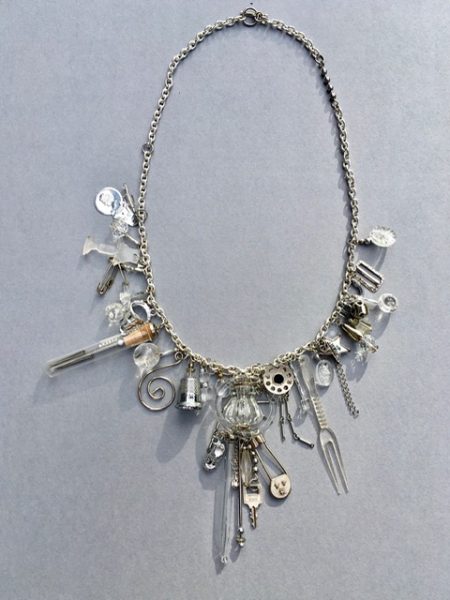
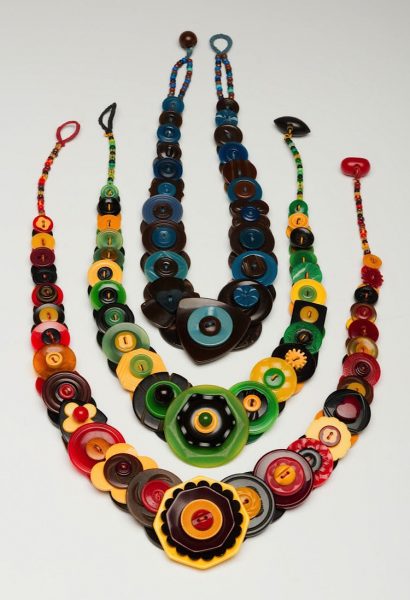
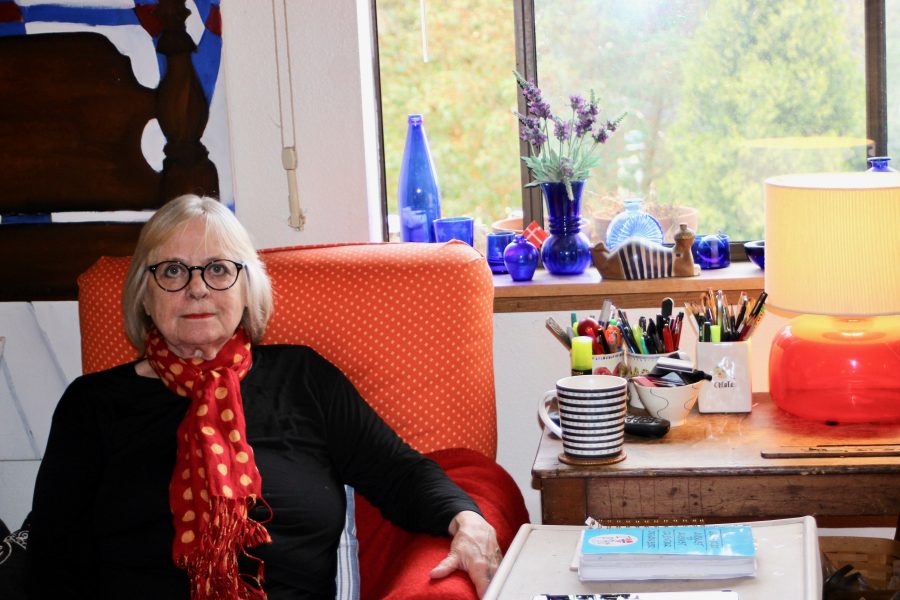
ABOUT LONE HANSEN. Lone is an artist who has owned several galleries in San Francisco, Seattle, and Bainbridge Island. She currently lives in Poulsbo where she is a member of the Poulsbo Arts League. During this pandemic and through her interactions with fellow artists, Lone has been creating art, gaining daily inspiration, cooking, and is taking care of dogs again. “I like this new normal,” she said. “It’s good for me – it is.” Lone has been “downsizing” her entire life – not just her studio, but her “whole life.” “It’s good to remember a life well lived,” she reflected. “Never boring, and it’s got me to where I am today.”